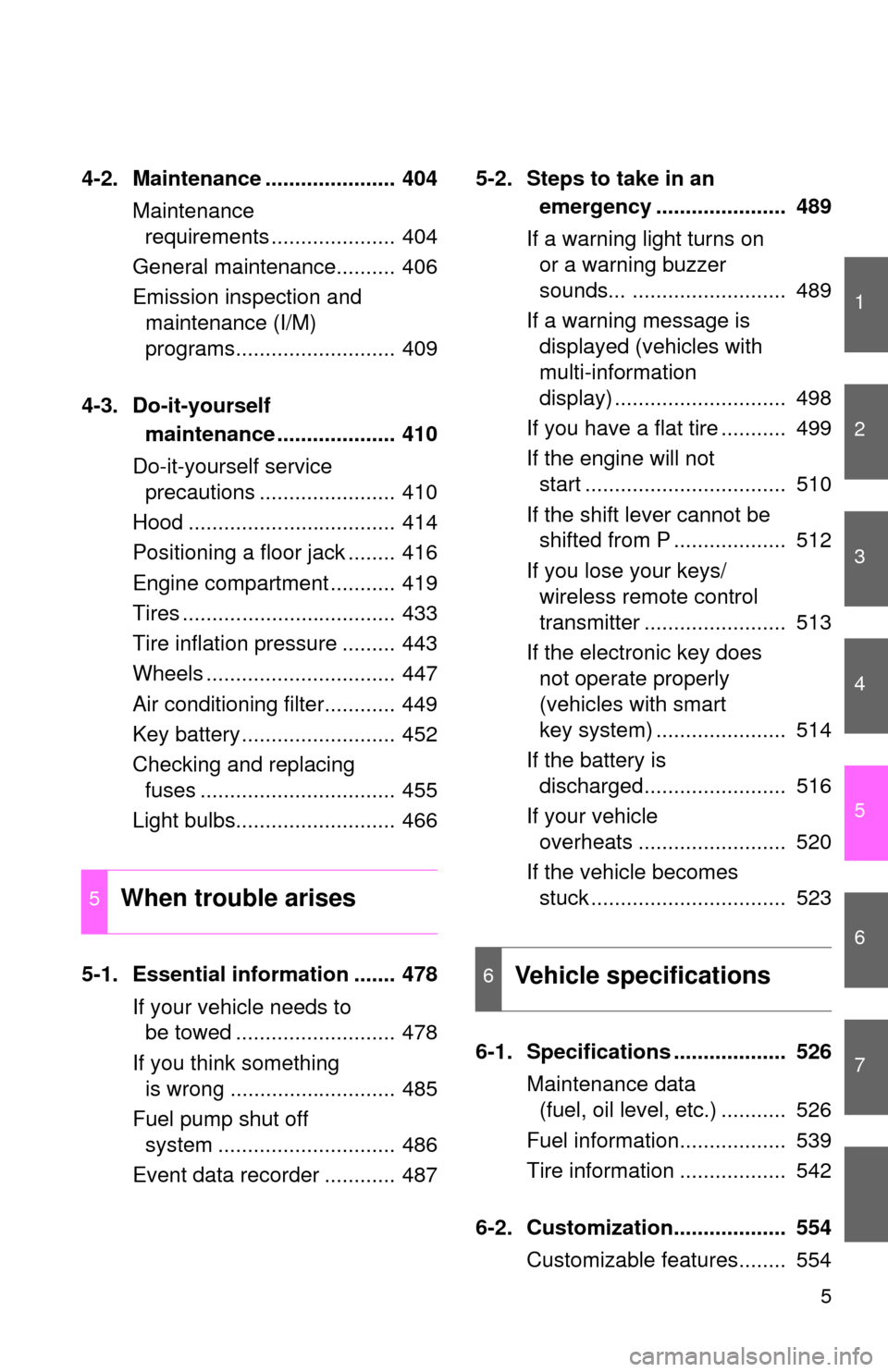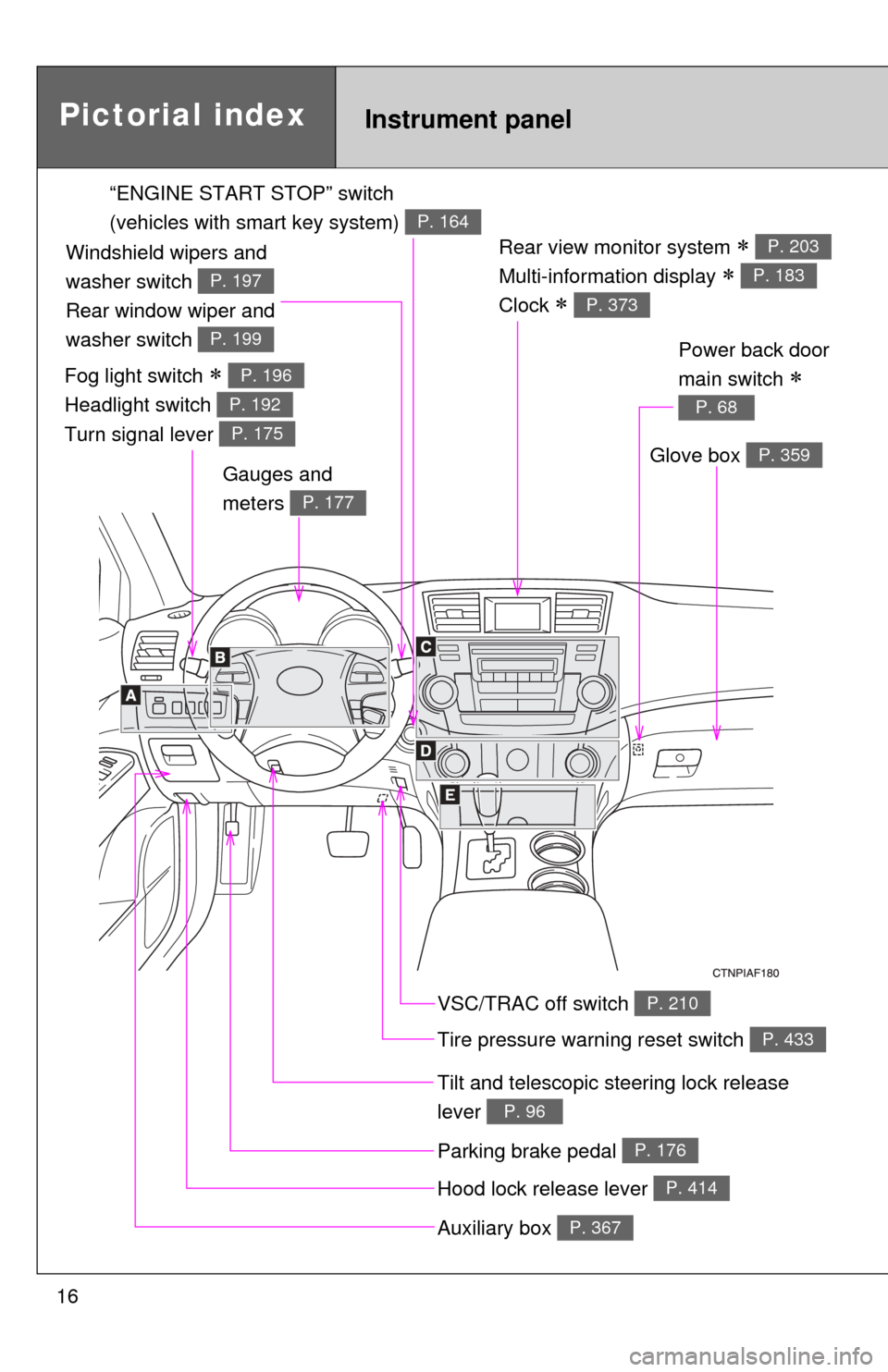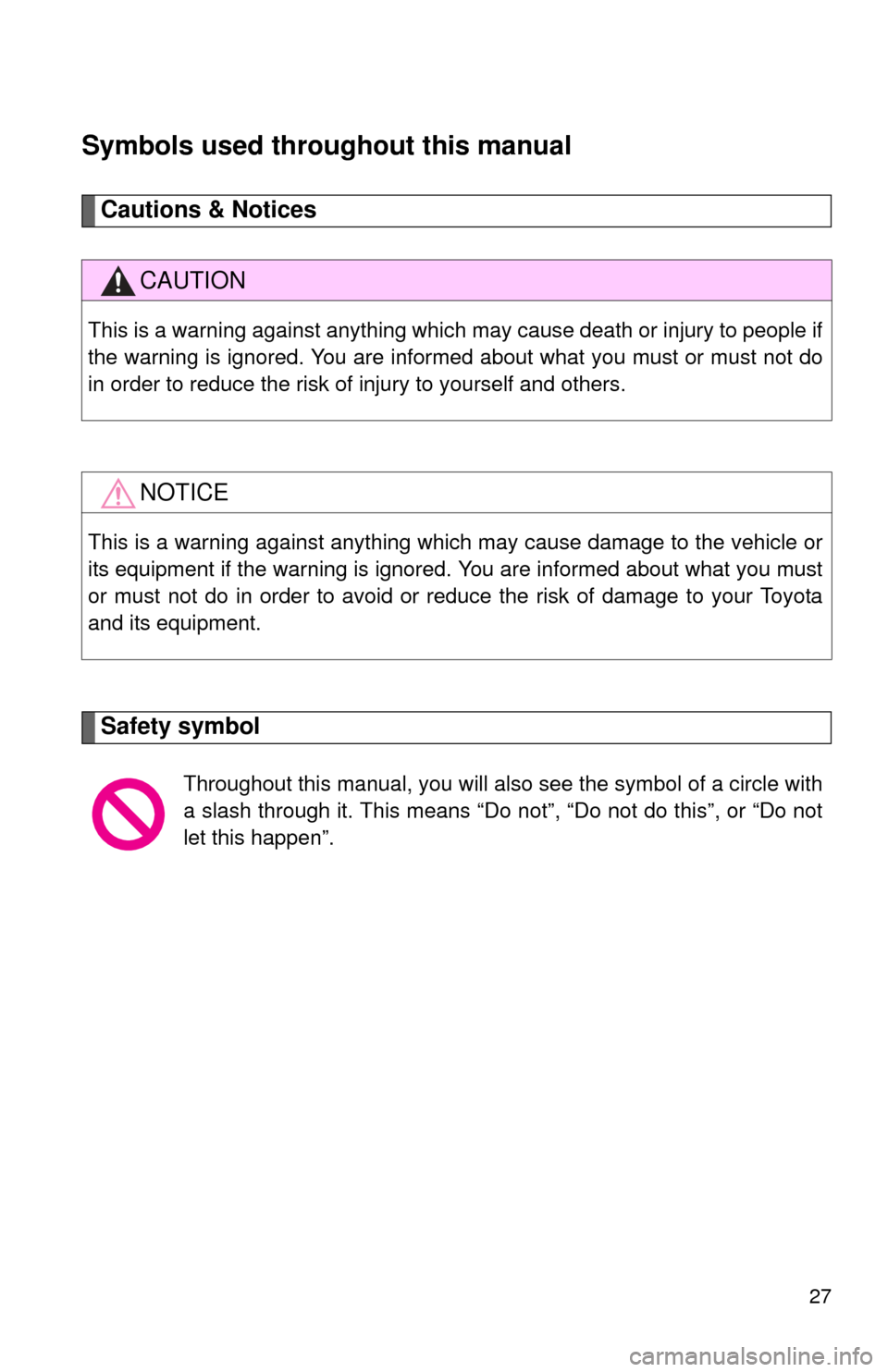warning TOYOTA HIGHLANDER 2008 XU40 / 2.G Owners Manual
[x] Cancel search | Manufacturer: TOYOTA, Model Year: 2008, Model line: HIGHLANDER, Model: TOYOTA HIGHLANDER 2008 XU40 / 2.GPages: 577, PDF Size: 11.46 MB
Page 2 of 577

TABLE OF CONTENTSIndex
2
1-1. Key information .................. 30Keys ..................................... 30
1-2. Opening, closing and locking the doors ............. 32
Smart key system................. 32
Wireless remote control ....... 53
Side doors ............................ 64
Back door ............................. 68
Glass hatch .......................... 73
1-3. Adjustable components (seats, mirrors,
steering wheel) ................. 75
Front seats ........................... 75
Rear seats ............................ 78
Head restraints ..................... 87
Seat belts ............................. 90
Steering wheel ..................... 96
Anti-glare inside rear view mirror .................................. 97
Outside rear view mirrors ..... 99
1-4. Opening and closing the windows and
moon roof ....................... 101
Power windows .................. 101
Moon roof ........................... 103
1-5. Refueling ........................... 106 Opening the fuel tank cap ................................... 106 1-6. Theft deterrent
system ............................. 110
Engine immobilizer system .............................. 110
Alarm .................................. 116
Theft prevention labels (U.S.A.)............................. 119
1-7. Safety information ............ 120 Correct driving posture ....... 120
SRS airbags ....................... 122
Front passenger occupant classification system ......... 134
Child restraint systems ....... 140
Installing child restraints ..... 144
2-1. Driving procedures........... 156 Driving the vehicle .............. 156
Engine (ignition) switch (vehicles with smart key
system) ............................. 164
Engine (ignition) switch (vehicles without smart
key system) ...................... 168
Automatic Transmission ..... 171
Turn signal lever ................. 175
Parking brake ..................... 176
2-2. Instrument cluster ............ 177 Gauges and meters ............ 177
Indicators and warning lights ................................. 179
Multi-information display ..... 183
1Before driving
2When driving
Page 5 of 577

1
2
3
4
5
6
7
5
4-2. Maintenance ...................... 404Maintenance requirements ..................... 404
General maintenance.......... 406
Emission inspection and maintenance (I/M)
programs........................... 409
4-3. Do-it-yourself maintenance .................... 410
Do-it-yourself service precautions ....................... 410
Hood ................................... 414
Positioning a floor jack ........ 416
Engine compartment ........... 419
Tires .................................... 433
Tire inflation pressure ......... 443
Wheels ................................ 447
Air conditioning filter............ 449
Key battery .......................... 452
Checking and replacing fuses ................................. 455
Light bulbs........................... 466
5-1. Essential information ....... 478 If your vehicle needs to be towed ........................... 478
If you think something is wrong ............................ 485
Fuel pump shut off system .............................. 486
Event data recorder ............ 487 5-2. Steps to take in an
emergency ...................... 489
If a warning light turns on or a warning buzzer
sounds... .......................... 489
If a warning message is displayed (vehicles with
multi-information
display) ............................. 498
If you have a flat tire ........... 499
If the engine will not start .................................. 510
If the shift lever cannot be shifted from P ................... 512
If you lose your keys/ wireless remote control
transmitter ........................ 513
If the electronic key does not operate properly
(vehicles with smart
key system) ...................... 514
If the battery is discharged........................ 516
If your vehicle overheats ......................... 520
If the vehicle becomes stuck ................................. 523
6-1. Specifications ................... 526 Maintenance data (fuel, oil level, etc.) ........... 526
Fuel information.................. 539
Tire information .................. 542
6-2. Customization................... 554 Customizable features........ 554
5When trouble arises
6Vehicle specifications
Page 16 of 577

16
Rear view monitor system
Multi-information display
Clock
P. 203
P. 183
P. 373
Gauges and
meters
P. 177
Tilt and telescopic steering lock release
lever
P. 96
Glove box P. 359
Pictorial indexInstrument panel
Power back door
main switch
P. 68
VSC/TRAC off switch P. 210
Tire pressure warning reset switch P. 433
Parking brake pedal P. 176
Hood lock release lever P. 414
Auxiliary box P. 367
“ENGINE START STOP” switch
(vehicles with smart key system)
P. 164
Fog light switch
Headlight switch
Turn signal lever P. 196
P. 192
P. 175
Windshield wipers and
washer switch
Rear window wiper and
washer switch
P. 197
P. 199
Page 27 of 577

27
Symbols used throughout this manual
Cautions & Notices
Safety symbol
CAUTION
This is a warning against anything which may cause death or injury to people if
the warning is ignored. You are informed about what you must or must not do
in order to reduce the risk of injury to yourself and others.
NOTICE
This is a warning against anything which may cause damage to the vehicle or
its equipment if the warning is ignored. You are informed about what you must
or must not do in order to avoid or reduce the risk of damage to your Toyota
and its equipment.Throughout this manual, you will also see the symbol of a circle with
a slash through it. This means “Do not”, “Do not do this”, or “Do not
let this happen”.
Page 40 of 577

40 1-2. Opening, closing and locking the doors
●The doors may unlock if a large amount of water splashes on the door
handle, such as in the rain or in a car wash. (The doors will automatically
be locked after approximately 60 seconds if the doors are not opened
and closed.)
● Gripping the door handle when wearing a glove may not unlock the door.
● If the wireless remote control is used to lock the doors when the elec-
tronic key is near the vehicle, there is a possibility that the door may not
be unlocked by the entry function. (Use the wireless remote control to
unlock the doors.)
■ When the vehicle is not driven for extended periods
To prevent theft of the vehicle, do not leave the electronic key within 6 ft. (2
m) of the vehicle.
■ Security feature
If a door is not opened within approximately 60 seconds after the vehicle is
unlocked, the security feature automatically locks the vehicle again.
■ Alarms and warning indicators
A combination of exterior and interior alarms as well as warning lights and
warning messages shown on the multi-information display are used to
reduce the chance of vehicle theft and accidents resulting from erroneous
operation.
●When any warning lights come on:
Take appropriate measures according to which warning light comes on.
( P. 489)
● When a warning message is shown on the multi-information display:
Take appropriate measures according to the warning message on the
multi-information display. ( P. 498)
Page 43 of 577

43
1-2. Opening, closing and locking the doors
1
Before driving
■
Customization that can be co nfigured at Toyota dealer
It is possible to deactivate the smart key system etc.
(Customizable features P. 554)
■ Certification for the smart key system
For vehicles sold in the U.S.A.
NOTE:
This device complies with Part 15 of the FCC Rules. Operation is subject to
the following two conditions: (1) This device may not cause harmful interfer-
ence, and (2) this device must accept any interference received, including
interference that may cause undesired operation.
NOTICE:
This equipment has been tested and found to comply with the limits for a
Class B digital device, pursuant to Part 15 of the FCC Rules. These limits
are designed to provide reasonable protection against harmful interference
in a residential installation. This equipment generates, uses and can radiate
radio frequency energy and, if not installed and used in accordance with the
instructions, may cause harmful interference to radio communications. How-
ever, there is no guarantee that interference will not occur in a particular
installation. If this equipment does cause harmful interference to radio or
television reception, which can be determined by turning the equipment off
and on, the user is encouraged to try to correct the interference by one or
more of the following measures:
● Reorient or relocate the receiving antenna.
● Increase the separation between the equipment and receiver.
● Connect the equipment into an outlet on a circuit different from that to
which the receiver is connected.
● Consult the dealer or an experienced radio/TV technician for help.
FCC WARNING:
Changes or modifications not expressly approved by the party responsible
for compliance could void the user's authority to operate the equipment.
FCC ID: NI4TMLF-3
Page 57 of 577

57
1-2. Opening, closing and locking the doors
1
Before driving
■
Reversing the operation of the power back door
Pressing the wireless remote control switch again while the power back door
is operating will cause the operation to reverse. However, the reverse opera-
tion cannot be performed for the first second after automatic operation starts,
even if the wireless remote control switch is pressed again.
■ Certification for wireless remote control
For vehicles sold in the U.S.A.
NOTE:
This device complies with Part 15 of the FCC Rules. Operation is subject to
the following two conditions: (1) This device may not cause harmful interfer-
ence, and (2) this device must accept any interference received, including
interference that may cause undesired operation.
NOTICE:
This equipment has been tested and found to comply with the limits for a
Class B digital device, pursuant to Part 15 of the FCC Rules. These limits
are designed to provide reasonable protection against harmful interference
in a residential installation. This equipment generates, uses and can radiate
radio frequency energy and, if not installed and used in accordance with the
instructions, may cause harmful interference to radio communications. How-
ever, there is no guarantee that interference will not occur in a particular
installation. If this equipment does cause harmful interference to radio or
television reception, which can be determined by turning the equipment off
and on, the user is encouraged to try to correct the interference by one or
more of the following measures:
● Reorient or relocate the receiving antenna.
● Increase the separation between the equipment and receiver.
● Connect the equipment into an outlet on a circuit different from that to
which the receiver is connected.
● Consult the dealer or an experienced radio-TV technician for help.
FCC WARNING:
Changes or modifications not expressly approved by the party responsible
for compliance could void the user's authority to operate the equipment.
Page 111 of 577

111
1-6. Theft deterrent system
1
Before driving
■
Certifications for the engine immobilizer system
●For vehicles sold in the U.S.A.
Vehicles without smart key system
FCC ID: MOZRI-20BTY
Vehicles with smart key system
FCC ID: NI4TMIMB-1
This device complies with Part 15 of the FCC Rules. Operation is subject to
the following two conditions: (1) this device may not cause harmful interfer-
ence, and (2) this device must accept any interference received, including
interference that may cause undesired operation.
FCC WARNING:
Changes or modifications not expressly approved by the party responsible
for compliance could void the user's authority to operate the equipment.
Page 123 of 577

123
1-7. Safety information
1
Before driving
Airbag system components
Your vehicle is equipped with ADVANCED AIRBAGS designed based
on US motor vehicle safety standards (FMVSS208). The airbag sys-
tem controls airbag deployment po wer for the driver and front pas-
senger. The driver airbag system cons ists of the driver seat's position
sensor etc. The front passenger's ai rbag system consists of the front
passenger occupant classification sensor etc. Curtain shield airbags
Side airbags
Front passenger airbag
Side and curtain shield air-
bag sensors
Front airbag sensors
Front passenger’s seat belt
buckle switch
Curtain shield airbag sen-
sors
“AIR BAG ON” and “AIR
BAG OFF” indicator lights
SRS warning light
Driver airbag
Driver’s seat position sen-
sor
Driver’s seat belt buckle
switch
Driver’s knee airbag
Airbag sensor assembly
Occupant detection system
(ECU and sensors)
Page 124 of 577

124 1-7. Safety information
The main SRS airbag system components are shown above. The
SRS airbag system is controlled by the airbag sensor assembly. The
airbag sensor assembly consists of a safing sensor and an airbag
sensor.
In certain types of severe frontal or side impacts, the SRS airbag sys-
tem triggers the airbag inflators. A chemical reaction in the inflators
quickly fills the airbags with non-toxic gas to help restrain the motion
of the occupants.
■ SRS warning light
This warning light system monitors the airbag sensor assembly, front airbag
sensors, side and curtain shield airbag sensor assemblies, curtain shield air-
bag sensor assemblies, driver's seat position sensor, driver's seat belt
buckle switch, front passenger occupant classification system, “AIR BAG
ON” and “AIR BAG OFF” indicator lights, front passenger’s seat belt buckle
switch, front seat belt pretensioner assemblies, inflators, interconnecting wir-
ing and power sources. ( P. 490)
■ If the SRS airbags deploy (inflate)
●Bruising and slight abrasions may result from contact with a deploying
(inflating) SRS airbag.
● A loud noise and white powder will be emitted.
● Parts of the airbag module (steering wheel hub, airbag cover and inflator)
as well as the front seats, and parts of the front and rear pillars and roof
side rail, may be hot for several minutes. The airbag itself may also be
hot.
● The front windshield may crack.